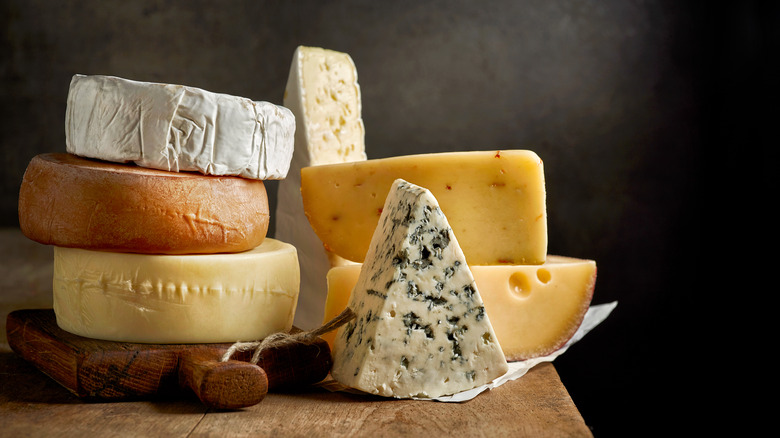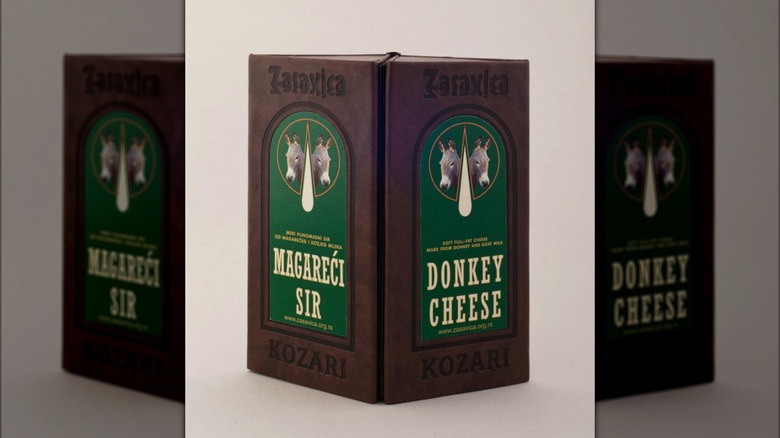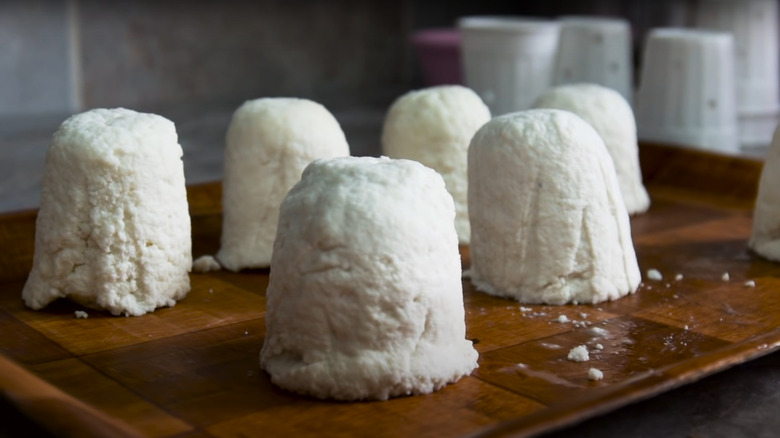The World's Most Expensive Cheese Is Actually Made From Donkeys
When you think of the most expensive cheese in the world, it's most often a wheel of Parmigiano Reggiano (not parmesan) that comes to mind. After all, a mere pound of the aged cow's milk cheese can cost between $15 to $25. Or perhaps, it's the Clawson Stilton Gold that you're thinking of — a type of white Stilton cheese flecked with real gold that sells for an eye-watering $76.50 for just under a quarter pound. But the beloved Parmigiano Reggiano or the blingy Stilton are not the world's costliest cheeses. That title belongs to pule — a Serbian cheese made from donkey milk.
Named after the Serbian term for foal, pule (also called magareći sir) is made from 40% goat milk and 60% donkey milk. However, it's not just any donkey's milk: Pule is a rare cheese because it is produced from a very specific breed of Balkan donkeys that are native to the Special Nature Reserve of Zasavica. This reserve was founded by Slobodan Simić in 1997 as a way to protect the dwindling population of endangered Serbian donkeys at the time. The valuable milk that they produced was then turned into soaps and moisturizers as well as rakia — a type of fruit brandy. As the number of the donkeys slowly grew in his reserve, Simić was left with an excess of milk. And so he decided to make pule with it: The world's first cheese from donkey milk that sells for several hundred a pound.
What makes pule the world's most expensive cheese?
Pule's steep price tag is due to two main factors: the donkeys that it is made from, and the time-consuming method of production. For one, the entire world's supply of pule cheese comes solely from the 200-odd Balkan donkeys that reside in the Special Nature Reserve of Zasavica and its partnering farms. Then, there is the fact these small number of donkeys produce very little milk. For instance, it takes 5.5 gallons of milk to make just over two pounds of pule, but a female donkey makes less than half a gallon of milk a day at most.
Plus, female donkeys (or jennies) only produce milk for six months, and the same jenny can't be milked again until at least a year passes. As a result, the Serbian reserve only manufactures about 110 and 154 pounds of pule annually.
What makes the cheese even more high-priced is that there is no specialized machinery suitable for milking donkeys to automate the entire process. Each donkey must be milked painstakingly by hand — and thrice every day at that! Besides, running a reserve and taking care of an endangered breed of donkeys comes with its own expenses, which cost Simić nearly $100,000 each year. Add all of it together, and you'll start to see why a pound of the Serbian donkey's milk cheese will set you behind at least a few hundred dollars.
So, what does a $600 cheese taste like?
The Serbian pule cheese tastes a lot like Spanish manchego, with a grassy aroma and a pale yellow hue. They are both soft, crumbly cheeses with a salty, zesty richness. But what sets pule apart is that it is made from donkey's milk, which is packed with considerably more vitamin C than its cow-based counterparts. This gives the mildly sweet cheese a more pronounced sourness as well. The semi-soft cheese doesn't have a wax rind and is typically sold in little pyramids the size of a golf ball. The cheese is sliced and served alongside cured meats including pork and donkey sausages, as well as with rakia or Turkish coffee to sip on.
Its taste and rarity aside, pule is a coveted cheese because it is made from donkey's milk — a drink that has a legendary reputation for its health benefits. Hippocrates used it to treat arthritis; Cleopatra bathed in it for her glowing, supple skin; and the milk has been used throughout history in folk medicine (via Healthline). Although it's unclear whether pule offers the same health benefits, it is rumored to be an excellent aphrodisiac (much like baked beans) — if you can afford its hefty price tag that is. Besides, pule isn't easily available either. The unpasteurized cheese can be bought at the Special Nature Reserve of Zasavica, either in person or through its online store if your state allows the sale of unpasteurized dairy (per the USDA).



